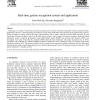Free Online Productivity Tools
i2Speak
i2Symbol
i2OCR
iTex2Img
iWeb2Print
iWeb2Shot
i2Type
iPdf2Split
iPdf2Merge
i2Bopomofo
i2Arabic
i2Style
i2Image
i2PDF
iLatex2Rtf
Sci2ools
IVC
2002
2002
Real-time gesture recognition system and application
In this paper, we consider a vision-based system that can interpret a user's gestures in real time to manipulate windows and objects within a graphical user interface. A hand segmentation procedure first extracts binary hand blob(s) from each frame of the acquired image sequence. Fourier descriptors are used to represent the shape of the hand blobs, and are input to radial-basis function (RBF) network(s) for pose classification. The pose likelihood vector from the RBF network output is used as input to the gesture recognizer, along with motion information. Gesture recognition performances using hidden Markov models (HMM) and recurrent neural networks (RNN) were investigated. Test results showed that the continuous HMM yielded the best performance with gesture recognition rates of 90.2%. Experiments with combining the continuous HMMs and RNNs revealed that a linear combination of the two classifiers improved the
| Added | 22 Dec 2010 |
| Updated | 22 Dec 2010 |
| Type | Journal |
| Year | 2002 |
| Where | IVC |
| Authors | Chan Wah Ng, Surendra Ranganath |
Comments (0)

